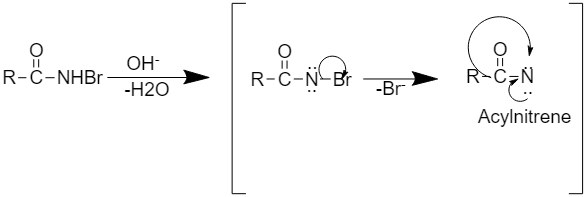
The Hofmann rearrangement of an amide, $RCON{H_2}$ to an amine $RN{H_2}$, is brought about by treating the amide with bromine in aqueous sodium hydride. Which of the species below is not an intermediate in Hofmann rearrangement?
A.$RNHCOOH$
B.$RN = C = O$
C.$RCONHR$
D.$RCON{H^ - }$
Answer
477k+ views
Hint:When a primary amide is treated with an aqueous or ethanolic solution of potassium hydroxide and bromine or potassium hypobromite (\[KOBr\]) it gives primary amine which has one carbon less than the original amide. This reaction is also known as the Hofmann bromamide reaction.
Complete step by step answer:Hofmann bromide or Hofmann degradation of primary amides reaction is given as:
$RCON{H_2} + B{r_2} + 4KOH \to RN{H_2} + {K_2}C{O_3} + 2KBr + 2{H_2}O$
This method is widely used for stepping down or descent homologous series. The mechanism of Hofmann's bromide reaction involves the formation of acyl nitrene as an intermediate which undergoes rearrangement to give alkyl isocyanate as an intermediate. The mechanism of Hofmann degradation reaction is given as:
Step1: This step involves the attack of a strong base to an amide.

Step2: This step involves the formation of intermediate acyl nitrene.

Step 3: This step involves the rearrangement to form alkyl isocyanate

Step 4: This step involves the formation of primary amine by hydrolysis of alkyl isocyanate as:

During the mechanism of the reaction, the intermediate compound formed is alkyl isocyanate
($RN = C = O$).
This mechanism has been supported by the observation that N-bromoamide and alkyl isocyanates have been isolated as intermediates in the above reaction.
Hence the correct answer is option B.
Additional information: In this reaction, the only primary amide is used for the formation of primary amine. We cannot use secondary and tertiary amide for the preparation of primary amine in this reaction.
Note: The formation of isocyanate as an intermediate in the above reaction is supported by the observation that when this reaction is carried out with methanolic $C{H_3}ONa$ instead of aqueous $NaOH$, a methyl carbamate or urethane is obtained instead of the amine.
Complete step by step answer:Hofmann bromide or Hofmann degradation of primary amides reaction is given as:
$RCON{H_2} + B{r_2} + 4KOH \to RN{H_2} + {K_2}C{O_3} + 2KBr + 2{H_2}O$
This method is widely used for stepping down or descent homologous series. The mechanism of Hofmann's bromide reaction involves the formation of acyl nitrene as an intermediate which undergoes rearrangement to give alkyl isocyanate as an intermediate. The mechanism of Hofmann degradation reaction is given as:
Step1: This step involves the attack of a strong base to an amide.

Step2: This step involves the formation of intermediate acyl nitrene.

Step 3: This step involves the rearrangement to form alkyl isocyanate

Step 4: This step involves the formation of primary amine by hydrolysis of alkyl isocyanate as:

During the mechanism of the reaction, the intermediate compound formed is alkyl isocyanate
($RN = C = O$).
This mechanism has been supported by the observation that N-bromoamide and alkyl isocyanates have been isolated as intermediates in the above reaction.
Hence the correct answer is option B.
Additional information: In this reaction, the only primary amide is used for the formation of primary amine. We cannot use secondary and tertiary amide for the preparation of primary amine in this reaction.
Note: The formation of isocyanate as an intermediate in the above reaction is supported by the observation that when this reaction is carried out with methanolic $C{H_3}ONa$ instead of aqueous $NaOH$, a methyl carbamate or urethane is obtained instead of the amine.
Recently Updated Pages
Master Class 9 General Knowledge: Engaging Questions & Answers for Success

Master Class 9 English: Engaging Questions & Answers for Success

Master Class 9 Science: Engaging Questions & Answers for Success

Master Class 9 Social Science: Engaging Questions & Answers for Success

Master Class 9 Maths: Engaging Questions & Answers for Success

Class 9 Question and Answer - Your Ultimate Solutions Guide

Trending doubts
Who is Mukesh What is his dream Why does it look like class 12 english CBSE

Who was RajKumar Shukla Why did he come to Lucknow class 12 english CBSE

The word Maasai is derived from the word Maa Maasai class 12 social science CBSE

What is the Full Form of PVC, PET, HDPE, LDPE, PP and PS ?

Which country did Danny Casey play for class 12 english CBSE

Differentiate between insitu conservation and exsitu class 12 biology CBSE




